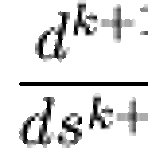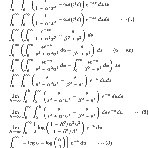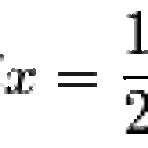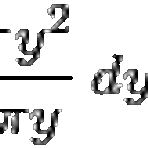Problem. Find the limit \begin{equation}\label{prob:lim} \lim_{n\to\infty} \frac{1}{n^{3/2}} \int_{-\infty}^{\infty} \frac{1 - \prod_{k=1}^{n} \cos (kx)}{x^2} \; dx. \end{equation} To find the value of \eqref{prob:lim}, we need some preliminaries. Lemma 1. For any $\alpha \in \mathbb{R}$, we have \begin{equation*} \int_{-\infty}^{\infty} \frac{1 - \cos (\alpha x)}{x^2} \; dx = \pi |\alpha|. \end..
Problem. Show that \begin{equation}\label{prob:wts} \int_{0}^{\infty} \frac{\cos ax}{x} \, \frac{\sinh\beta x}{\cosh\gamma x} \, dx = \frac{1}{2} \, \log \left( \frac{\cosh\frac{a\pi}{2\gamma}+\sin\frac{\beta\pi}{2\gamma}}{\cosh\frac{a\pi}{2\gamma}-\sin\frac{\beta\pi}{2\gamma}} \right) \end{equation} for $|\Re \beta| < \Re \gamma$. (Original Problem by Doe John, in his posting [1].) To prove \eq..
오늘의 계산 시리즈로 여러분들을 다시 찾아뵙는 것은 정말 오랜만이네요. 거의 반 년 가까이 계산을 놓고 있었는데, 오늘 좋은 떡밥을 하나 줏어서 열심히 머리굴린 덕에 계산해낼 수 있었습니다. 한 3시간 정도 매달린 것 같네요. 아, 어지러워... 진리의 미쿠로 다시 회복하고 확률미방이나 공부해야겠네요. Problem. Find the value of the integral \begin{equation*} \int_{0}^{1} \frac{\log \log (1/x)}{1+x^2} \; dx. \end{equation*} Solution. By the substitution \( x = e^{-t} \), we find that \begin{align*} \int_{0}^{1} \frac{(\log (1/..
 오늘의 계산 43 - Calculations of Four Integrals
오늘의 계산 43 - Calculations of Four Integrals
Here I post my solutions to the announced four integrals. I tacitly assumed some formulas to be granted, so to reduce unnecessary calculations that are attainable in regular courses in analysis. One exception to this convention is the detailed proofs for the identity \begin{equation*} \int_{0}^{\infty} \frac{\cos x}{x^2 + \beta^2} \; dx = \frac{\pi}{2\beta} e^{-\beta} \end{equation*} for $\beta ..
 오늘의 계산 42 - A Product related to Dedekind eta function
오늘의 계산 42 - A Product related to Dedekind eta function
Problem. Show the identity \begin{equation} \label{pb:wts} \prod_{n=1}^{\infty} \left(1 + e^{- \pi n}\right) = 2^{-\frac{1}{8}} e^{\frac{\pi}{24}}. \end{equation} Proof. This is related to the famous Dedekind eta function $\eta(s)$, which is defined by \begin{equation*} \eta(\tau) = e^{\frac{\pi i \tau}{12}} \prod_{n=1}^{\infty} \left( 1 - e^{2\pi i n \tau} \right), \end{equation*} although we d..
 오늘의 계산 41 - Realizing Nonsensical (in progress)
오늘의 계산 41 - Realizing Nonsensical (in progress)
오늘은, 소설로 치면 그냥 커뮤니티에 의미도 없이 순간 흥해서 싸질러보는 무의미한 줄거리에 가까운 계산입니다. 뭔가 '아, 이런 적분에 의미를 줄 수 있을까' 하는 생각에서 출발해봤는데, 그냥 뭐 그렇네요 -_-;; Let $ f $ be a measurable function on $ (0, \infty) $. If \begin{equation} \label{def:ctr} \int_{h}^{\infty} f(x) \, \frac{dx}{x} = -\log h + c + o(1) \quad \text{as} \ h \to 0^{+} \end{equation} for some complex number $ c $, then we call $ c $ the center of $ f $ and denote ..
Today we are going to prove the following equality. Problem. Show that Proof. Let denote this integral hereafter. To achieve this, we first observe by double-angle formula that Here, we used the transformation for each step. Then by symmetry, this is written as Then by the identity we have Then we make change of variable to obtain where denote the counterclockwised unit circle centered at the or..
 오늘의 계산 39 - Abel's Integral
오늘의 계산 39 - Abel's Integral
Today's integral is so called Abel's integral, which is given by Problem. \begin{equation} \label{eq:prob} \int_{0}^{\infty} \frac{t \; dt}{(e^{\pi t} - e^{-\pi t})(t^2 + 1)} \end{equation} Now our aim is to evaluate \eqref{eq:prob} in closed form. We preliminarily introduce a function that will play a key role throughout the calculation. Let $k$ be a nonnegative integer. Then we define polygamm..
 오늘의 계산 38 - Coxeter's Integrals (2)
오늘의 계산 38 - Coxeter's Integrals (2)
오늘 올리는 계산은 Coxeter's Integrals라는 적분의 계산입니다. 사실 이 적분을 처음 접한 것은 몇 년 전이지만, 그 동안은 번번히 계산에 실패했었습니다. 그러던 중, 지난 번 「오늘의 계산 37」의 접근법을 기본으로 하고, 아크코사인을 적절히 변형하는 방법을 발견해내어 이렇게 계산에 성공하게 되었습니다. 으, 참으로 긴 여정이었습니다만 그만큼 뿌듯하긴 하네요. Problem (Coxeter's integrals). Verify the following identities. \begin{align} \int_{0}^{\frac{\pi}{2}} \cos^{-1} \left( \frac{\cos x}{1+2\cos x}\right) \, dx & = \frac{5}{4} \zeta(2) \la..
 오늘의 계산 37 - Coxeter's Integrals (1)
오늘의 계산 37 - Coxeter's Integrals (1)
Today's integral is a famous one. $$ \int_{0}^{\frac{\pi}{4}} \arctan\sqrt{\frac{\cos2\theta}{2\cos^2\theta}} \, \mathrm{d}\theta = \frac{\pi^2}{24}. $$ To calculate this, we first note that \begin{gather*} \arctan(\alpha) = \int_{0}^{1} \frac{\alpha}{1+\alpha^2 x^2} \, \mathrm{d}x, \tag{1} \\ \int_{0}^{\infty} \frac{\mathrm{d}x}{(x^2+\alpha^2)(x^2 + \beta^2)}=\frac{\pi}{2\alpha\beta(\alpha+\bet..
 오늘의 계산 36 - Integration of a Fejer kernel-like thing
오늘의 계산 36 - Integration of a Fejer kernel-like thing
…을 가장한, 옛날에 AoPS에 답변으로 올렸지만 티스토리로 퍼오기 매우 귀찮아서 그냥 방치했던 계산 하나를 올려봅니다. 다른 꼴의 삼각함수 적분에도 쓸 수 있는 테크닉이 아닐까 해서 이렇게 올려봅니다. Today's integral we are going to evaluate is a famous one, . Solution 1 (by elementary calculus). It is clear that . To determine for , we consider the difference for . Some trigonometric identities show that Since it follows that and for . Therefore for all . Solution 2 (by complex ..
오늘 계산은 지금까지 MathLinks에 답변했던 계산들 중 2개를 추려서 올려본 것입니다. 이번에 계산할 적분은 아래 적분입니다. 특별한 설명 없이 쭉 이어나가겠습니다. \begin{align*} I & = \int_{0}^{1}\frac{\sqrt{x-x^{2}}}{(1+x^{2})^{2}}\, \mathrm{d}x \\ &= \int_{0}^{\infty}\frac{\sqrt{y}(1+y)}{(1+(1+y)^{2})^{2}}\, \mathrm{d}t \tag{$x = 1/(1+y)$} \\ &= \frac{1}{4} \int_{0}^{\infty} \frac{\mathrm{d}y}{\sqrt{y}(1+(1+y)^{2})} \tag{IbP} \\ &= \frac{1}{2} \int_{0}^{\inft..
 오늘의 계산 34 - Two Integrals
오늘의 계산 34 - Two Integrals
블로그의 정체를 막기 위해 오늘도 쉬운 계산 몇 가지를 적어보고자 합니다. [계산 1] α, β > 0 일 때 다음 계산이 성립합니다. 여기서 특별한 설명이 필요한 부분은 (1)에서 (4)에 해당하는 부분입니다. 우선 (1)은 제가 예전에 올린 글 중에서 적분의 교환가능성을 약간 확장한 것에 대한 글을 참조하시면 됩니다. 그리고 (2)와 (3)은 Lebesgue's dominated convergence theorem을 적용하면 되고, (4)는 감마함수의 미분으로부터 유도됩니다. [계산 2] 역시 쉬운 계산입니다. 오일러 적분의 일종이죠. 앗흥~
Problem. Evaluate the following integral. \begin{equation}\label{eqn:wts} \int_{0}^{1} \log (1-x) \log x \log (1+x) \; dx \end{equation} We divide the solution into several steps. 1. Reduction to Euler series. The key ingredient for the reduction is the following integral. \begin{equation*} \int_{0}^{\frac{\pi}{2}} \sin^{p} \theta \cos^{q} \theta \log \sin\theta \log \cos\theta \; d\theta. \end{..
 오늘의 계산 31 - An Integral (With Logarithmic Behavior)
오늘의 계산 31 - An Integral (With Logarithmic Behavior)
Problem. Evaluate the following integral. \begin{equation}\label{eqn:wts} \int_{0}^{1}\frac{\log \cos ( \frac{\pi x}{2} )}{x (x+1)} \, dx \end{equation} We first introduce a lemma which will play the key role to our calculation. Lemma. Define the function $F(s)$ by \begin{equation*} F(s) = \int_{0}^{1} \frac{\log | \cos (sx) | }{x} \, dx - \int_{1}^{2} \frac{\log | \sin (sx) | }{x} \, dx. \end{e..
 오늘의 계산 29 - Alternating Euler Sum involving Binomial (2n, n)
오늘의 계산 29 - Alternating Euler Sum involving Binomial (2n, n)
Problem. Prove the following identities. \begin{equation}\label{eqn:wts} \sum_{n=1}^{\infty} \frac{(-1)^{n-1}}{n^3 \binom{2n}{n}} = \frac{2}{5} \zeta(3), \qquad \sum_{n=1}^{\infty} \frac{(-1)^{n-1}}{n^3 2^n \binom{2n}{n}} = \frac{1}{4} \zeta(3) - \frac{1}{6}\log^3 2 \end{equation} We divide the proof into several lemmas. Lemma 1. For $|x| < 1$. \begin{equation}\label{eqn:wts_lem_1} \int_{0}^{x} ..
 오늘의 계산 28 - Exotic Integral by G.H.Hardy
오늘의 계산 28 - Exotic Integral by G.H.Hardy
여러분, 정말 오랜만입니다. 거의 2달만에 블로그에 새 글을 남기네요. 오늘 가져온 계산은 1908년 G.H.Hardy가 저널 Messenger of Mathematics에 소개한 기묘한 적분 몇 개를 제가 직접 계산하는 데 성공하고, 그 결과가 타당한 범위를 좀 더 넓혀본 것입니다. 오늘 소개할 적분은 입니다. 단, β는 Re(β), Im(β) ≥ 0 을 만족하는 임의의 복소수입니다. 위 등식의 유도 및 증명과정은 아래의 스프링노트에 담겨 있습니다. 계산 노트 #007 (http://sos440.springnote.com/pages/4799193) 그럼 다음에 다시 만날 수 있기를 바라면서, 저는 다시 생활관으로...
- Total
- Today
- Yesterday
- 푸리에 변환
- 감마함수
- 계산
- 린
- 유머
- Integral
- Zeta function
- 제타함수
- 무한급수
- Fourier Transform
- infinite summation
- Euler constant
- 보컬로이드
- 미쿠
- 편미방
- 오일러 상수
- 렌
- Coxeter
- 적분
- Gamma Function
- 해석학
- 루카
- binomial coefficient
- Euler integral
- 대수기하
- Beta function
- 노트
- 오일러 적분
- 수학
- 이항계수
| 일 | 월 | 화 | 수 | 목 | 금 | 토 |
|---|---|---|---|---|---|---|
| 1 | 2 | 3 | 4 | 5 | ||
| 6 | 7 | 8 | 9 | 10 | 11 | 12 |
| 13 | 14 | 15 | 16 | 17 | 18 | 19 |
| 20 | 21 | 22 | 23 | 24 | 25 | 26 |
| 27 | 28 | 29 | 30 |


